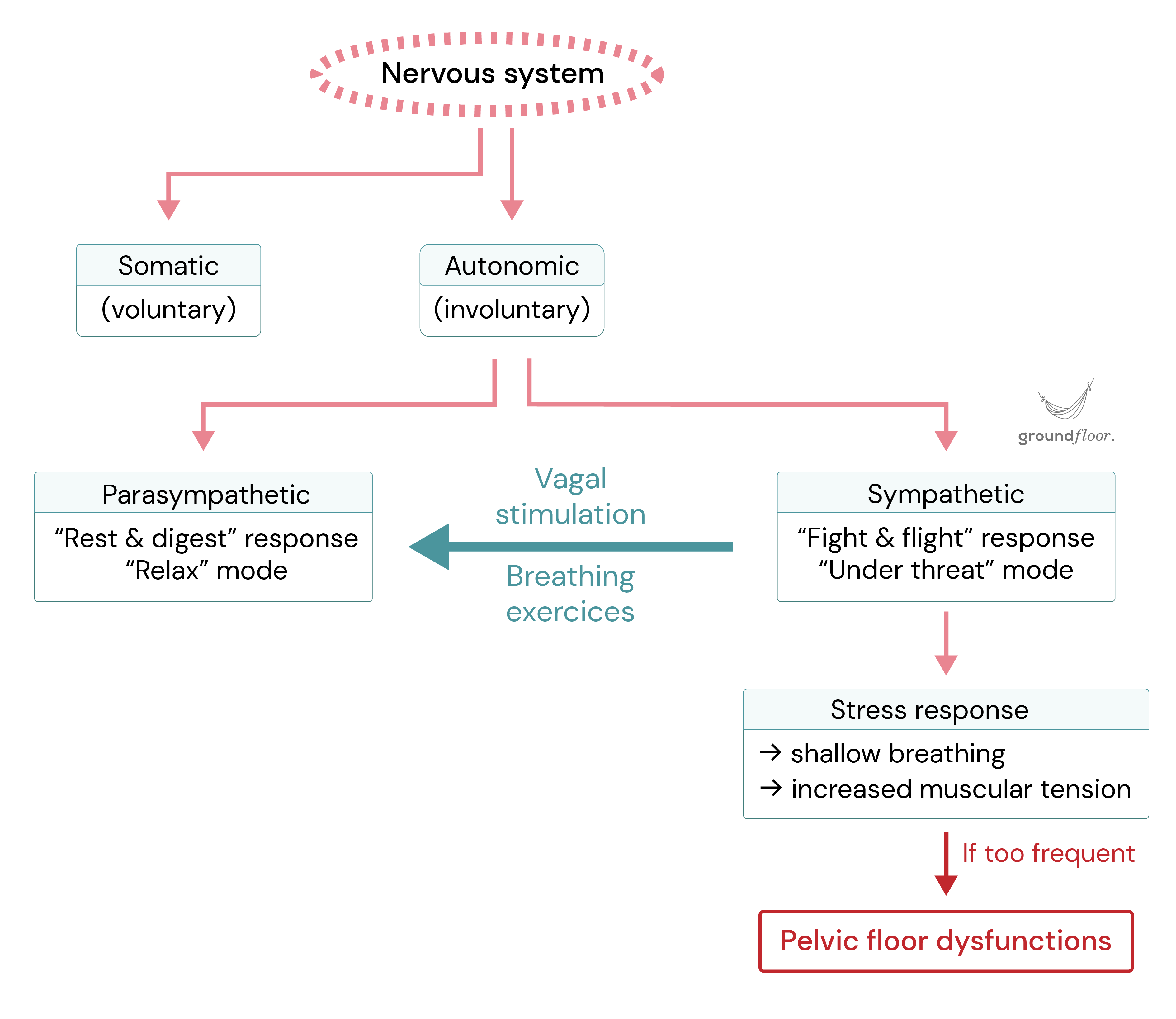
While it is well known that stress can have a detrimental impact on your overall health, have you ever considered its effects on your pelvic floor?
This article will explore how your nervous system toggles between two modes to manage your body's functions. We will uncover what happens in your pelvic floor when this equilibrium is disrupted due to stress. We will also delve into the effectiveness of breathing exercises in stimulating your vagus nerve to regulate your nervous system and restore this balance.
The divisions of the nervous system
The nervous system plays a crucial role in regulating and coordinating the body's functions. It is divided into two main divisions: the somatic and the autonomic systems. In this article, we will focus on the autonomic nervous system, which operates involuntarily and is further divided into two branches: the sympathetic and parasympathetic nervous systems.
The parasympathetic nervous system, often called the "rest and digest" response, operates most of the time and maintains the body's usual functions as well as promotes relaxation.
In contrast, the sympathetic nervous system, known as the "fight or flight" response, is activated under stress when a threat is perceived. It acts like an emergency switch, preparing the body to respond swiftly to potential dangers. For instance, if you were to encounter a lion, your body would prioritise immediate survival by increasing your heart rate, diverting oxygen to major muscles for a burst of speed, and reducing sensitivity to pain, allowing you to flee from the threat.
This automatic response is not under voluntary control and can occur even in non-life-threatening situations. Remember those moments of panic when you can't locate your phone, causing your heart to race? That's your sympathetic nervous system at work. It is initially intended as a protective mechanism, but it can become problematic when overactive. Our bodies are not designed to maintain this heightened state for extended periods.

How stress translates in your body
Unfortunately, the demands and pressures of modern life often subject us to a constant and imperceptible sense of threat, unwittingly trapping us in a perpetual "fight-or-flight" mode. This frequent activation of the sympathetic nervous system can adversely affect our overall health, including the well-being of our pelvic floor.
Indeed, your pelvic floor's tone is closely tied to your overall body tone, which tends to increase as part of the "fight-or-flight" mechanism. Think of it this way: when stress strikes, your body responds with muscle tension, and your pelvic floor is no exception. It ends up as tense as the rest of your body.
For the sake of your pelvic health, it is wise to keep the sympathetic system in check, as excessive tension in the pelvic floor, brought on by stress, can lead to various dysfunctions.
Moreover, during stressful periods, shallow breathing often becomes our default response. As mentioned in a prior article, this breathing pattern at rest is less favourable for the pelvic floor than diaphragmatic breathing. This further emphasises the importance of stress management. You can establish a more suitable breathing strategy by reducing an excessive 'fight-or-flight' response and encouraging a shift towards the beneficial 'rest and digest' mode. This transition supports the optimal functioning of the pelvic floor, safeguarding it from potential dysfunctions.
Vagal stimulation
You might be thinking that reducing stress is easier said than done. However, there's an effective approach that might not be as challenging as you assume: vagal stimulation through breathing exercises.
These exercises activate the vagus nerve, which has a calming effect on the organs affected by the 'fight-or-flight' response. It helps shift your body into a 'rest and digest' state, reducing tension not only in your body but also in the pelvic floor. Think of it like turning off the emergency switch mentioned earlier.
Moreover, these exercises promote a healthy breathing pattern at rest, allowing your pelvic floor to function optimally. They can also have positive effects on various other conditions that affect pelvic health, such as digestive disorders (like IBS or Crohn's) or inflammatory diseases, among others.
These beneficial breathing exercises are available through our app for individuals whose pelvic health check-up indicates a need for pelvic floor relaxation or stress management.
Share this article with your friends and help spread the knowledge together! ↓
Share this article with your friends and help spread the knowledge together! →





Download the app to learn more about this topic and receive tailored information about your pelvic health!


Related articles

7 min read
The truth about having a tight pelvic floorA hypertonic or overactive pelvic floor (distinct from an overactive bladder) results from the buildup of excessive tension within the muscles. In this situation, the pelvic floor can also be referred to as "tight", which is often wrongly believed to be a good thing. This article will debunk this myth and shed light on the misconceptions surrounding this topic. Delving into the consequences of such a condition, we will also explore the common errors that can lead to a hypertonic pelvic floor and provide effective and practical strategies to address it.
→ Read more

10 min read
Unlocking pleasure: Your pelvic floor's secret to fulfilling sex!Experiencing pain during intercourse? Struggling with sensations or achieving orgasm? Contrary to common beliefs, many sexual dysfunctions are not psychogenic or hormonal in nature. Instead, they often stem from pelvic floor issues. This article will uncover strategies to improve your pelvic health while elevating your sexual life to unprecedented levels.
To start, we will explore the anatomy of the clitoris, its relationship with the pelvic floor, and their roles in the context of sexual activities. Then, we will explore prevalent dysfunctions and conditions that contribute to these challenges and provide insights into effective approaches for resolution. Finally, we will delve into the intricate interplay of physical, mental, and emotional factors within the multifaceted realm of sexuality.
→ Read more

4 min read
Breathing with your pelvic floor and the connection with the coreDid you know that your pelvic floor is a key component of your core and a breathing muscle? If this statement surprises you, keep reading to explore the intriguing connection!
In this article, we will delve into the anatomy of the core and biomechanics of breathing. We will also discuss different breathing patterns, their effects on the pelvic floor, and the benefits of practising diaphragmatic breathing.
→ Read more

